Support Vector Machine in R: Using SVM to Predict Heart Diseases
This article explores how to use the SVM algorithm to predict heart disease.
Join the DZone community and get the full member experience.
Join For Free
Support Vector Machine in R
With the exponential growth in AI, machine learning is becoming one of the most sought after fields. As the name suggests, machine learning is the ability to make machines learn through data by using various machine learning algorithms, and in this blog, we’ll discuss how the SVM algorithm works, the various features of SVM, and how it is used in the real world.
You may also like: Introduction to Classification Algorithms
Introduction to Machine Learning
Machine learning is a science of getting computers to act by feeding them data and letting them learn a few tricks on their own, without being explicitly programmed to do so.
The key to machine learning is the data. Machines learn just like us humans. We humans need to collect information and data to learn. Similarly, machines must also be fed data in order to learn and make decisions.
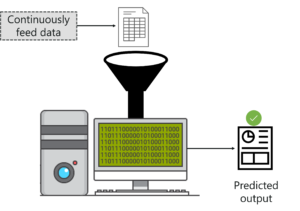
To understand machine learning, let’s consider an example. Let’s say you want a machine to predict the value of a stock. In such situations, you just feed the machine with relevant data. After that, you must create a model that is used to predict the value of the stock.
One thing to keep in mind is, the more data you feed the machine, the better it’ll learn and make more accurate predictions.
Obviously, ML is not so simple. For a machine to analyze and get useful insights from data, it must process and study the data by running different algorithms on it. And in this blog, we’ll be discussing one of the most widely used algorithms called SVM.
Types of Machine Learning
Now that you have a brief idea about machine learning, let’s look at the different ways in which machines learn.
1. Supervised Learning
Supervised means to oversee or direct a certain activity and make sure it’s done correctly. In this type of learning the machine learns under guidance.
At school, our teachers guided us and taught us, similarly in supervised learning, you feed the model a set of data called training data, which contains both input data and the corresponding expected output. The training data acts as a teacher and teaches the model the correct output for a particular input so that it can make accurate decisions when later presented with new data.
2. Unsupervised Learning
Unsupervised means to act without anyone’s supervision or direction.
In unsupervised learning, the model is given a data set that is neither labeled nor classified. The model explores the data and draws inferences from data sets to define hidden structures from unlabeled data.
An example of unsupervised learning is an adult-like you and me. We don’t need a guide to help us with our daily activities, we figure things out on our own without any supervision.

3. Reinforcement Learning
Reinforcement means to establish or encourage a pattern of behavior. Let’s say you were dropped off at an isolated island, what would you do?
Initially, you’d panic and be unsure of what to do, where to get food from, how to live, and so on. But after a while, you will have to adapt, and you must learn how to live on the island, adapt to the changing climates, and learn what to eat and what not to eat.
You’re following what is known as the trial and error concept because you’re new to this surrounding and the only way to learn is to experience and then learn from your experience.
This is what reinforcement learning is. It is a learning method wherein an agent (you, stuck on an island) interacts with its environment (island) by producing actions and discovers errors or rewards.
What Is SVM?
SVM (Support Vector Machine) is a supervised machine learning algorithm that is mainly used to classify data into different classes. Unlike most algorithms, SVM makes use of a hyperplane, which acts like a decision boundary between the various classes.
SVM can be used to generate multiple separating hyperplanes such that the data is divided into segments and each segment contains only one kind of data.

Before moving further, let’s discuss the features of SVM:
- SVM is a supervised learning algorithm. This means that SVM trains on a set of labeled data. SVM studies the labeled training data and then classifies any new input data depending on what it learned in the training phase.
- A main advantage of SVM is that it can be used for both classification and regression problems. Though SVM is mainly known for classification, the SVR (Support Vector Regressor) is used for regression problems.
- SVM can be used for classifying non-linear data by using the kernel trick. The kernel trick means transforming data into another dimension that has a clear dividing margin between classes of data. After which you can easily draw a hyperplane between the various classes of data.
How Does SVM Work?
In order to understand how SVM works let’s consider a scenario.
For a second, pretend you own a farm and you have a problem — you need to set up a fence to protect your rabbits from a pack of wolves. But where do you build your fence?
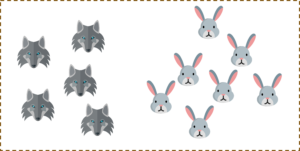
One way to get around the problem is to build a classifier based on the position of the rabbits and wolves in your pasture.
So if I do that and try to draw a decision boundary between the rabbits and the wolves, it looks something like this. Now you can clearly build a fence along this line.

In simple terms, this is exactly how SVM works. It draws a decision boundary, i.e. a hyperplane between any two classes in order to separate them or classify them.
Now I know you’re thinking how do you know where to draw a hyperplane?
The basic principle behind SVM is to draw a hyperplane that best separates the 2 classes. In our case, the two classes are rabbits and wolves. Before we move any further, let’s try to understand what a support vector is.
What Is a Support Vector in SVM?
So, you start by drawing a random hyperplane and then you check the distance between the hyperplane and the closest data points from each class. These closest data points to the hyperplane are known as support vectors. And that’s where the name comes from, support vector machine.

The hyperplane is drawn based on these support vectors and an optimum hyperplane will have a maximum distance from each of the support vectors. And this distance between the hyperplane and the support vectors is known as the margin.
To sum it up, SVM is used to classify data by using a hyperplane, such that the distance between the hyperplane and the support vectors is maximum.
Alright, now let’s try to solve a problem.
Let’s say that I input a new data point and now I want to draw a hyperplane such that it best separates these two classes.
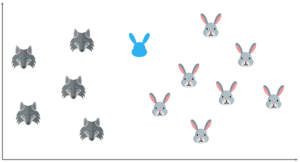
So, I start off by drawing a hyperplane and then I check the distance between the hyperplane and the support vectors. Here I’m basically trying to check if the margin is maximum for this hyperplane.
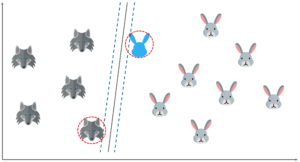
But what if I draw the hyperplane like this? The margin for this hyperplane is clearly more than the previous one. So, this is my optimal hyperplane.
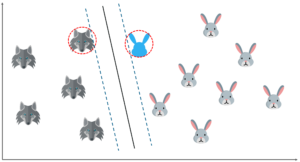
So far it's been quite easy. Our data was linearly separable, which means that you could draw a straight line to separate the two classes!
But what will you do if the data set is like this?

You possibly can’t draw a hyperplane like this! It doesn’t separate the two classes.
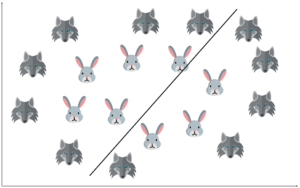
This is where Non-linear SVM is implemented.
Non-Liner Support Vector Machine
Earlier in this blog, I mentioned how a kernel can be used to transform data into another dimension that has a clear dividing margin between classes of data.
Kernel functions offer the user the option of transforming nonlinear spaces into linear ones.
Until this point, we were plotting our data on 2-dimensional space. So, we had only 2 variables, x and y.
A simple trick would be transforming the two variables x and y into a new feature space involving a new variable z. Basically, we’re visualizing the data on a 3-dimensional space.
When you transform the 2D space into a 3D space you can clearly see a dividing margin between the 2 classes of data. And now you can go ahead and separate the two classes by drawing the besthyperplane between them.
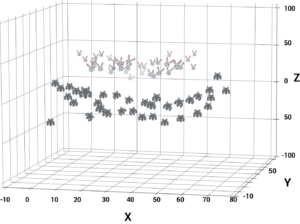
This sums up the idea behind Non-linear SVM. To understand the real-world applications of a Support Vector Machine let’s look at a use case.
Use Case — SVM
SVM as a classifier has been used in cancer classification since the early 2000’s.
A group of professionals held an experiment to classify colon cancer tissue by using SVM. The dataset consisted of about 2000 transmembrane protein samples and only about 50-200 gene samples were input into the SVM classifier. The sample input to the SVM had both colon cancer tissue samples and normal colon tissues.

The main objective of this study was to classify gene samples based on whether they are cancerous or not. So SVM was trained using the 50-200 samples in order to discriminate non-tumor from tumor specimens. The performance of the SVM classifier was very accurate for even a small data set and its performance was compared to other classification algorithms like Naïve Bayes and in each case, the SVM outperformed Naive Bayes.
So after this experiment, it was clear that SVM classified the data more effectively and it worked exceptionally good with small data sets.
Support Vector Machine Demo
Alright, now let’s get into the practical part. We’ll run a demo to better understand how SVM can be used as a classifier.
A lot of people have this question in mind:
What Is SVM in R?
The answer is, R is basically an open source statistical, programming language used mainly in the field of Data Science.
Problem Statement
To study a heart disease data set and to model a classifier for predicting whether a patient is suffering from any heart disease or not.

In this demo, we’ll be using the caret package. The caret package, also known as classification and regression training, has tons of functions that help build predictive models. It contains tools for data splitting, pre-processing, feature selection, tuning, unsupervised learning algorithms, etc.
So, to use it, we first need to install it using this command:
install.packages(“caret”)The caret package is very helpful because it provides us direct access to various functions for training our model with various machine learning algorithms like KNN, SVM, decision tree, linear regression, etc.
After installing it, we just need to load the package into our console, to do that we have this code:
library('caret')Our next step is to load the data set.
For this demo, we’ll be using a Heart Disease data set, which consists of various attributes like the person’s age, sex, cholesterol level, etc. In the same data set, we’ll have a target variable, which is used to predict whether a patient is suffering from any heart disease or not
In short, we’ll be using SVM to classify whether a person is going to be prone to heart disease or not.
The data set looks like this:
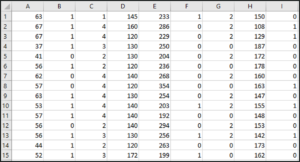
This dataset has around 14 attributes and the last attribute is the target variable, which we’ll be predicting using our SVM model.
Now it’s time to load the data set:
heart <- read.csv("/Users/zulaikha/Desktop/heart_dataset.csv", sep = ',', header = FALSE)In the above line of code, we’re reading the dataset, which is stored in a CSV format, and that’s why we’ve used the read.csv function to read it from the specified path.
The ‘sep’ attribute indicates that the data is stored in a CSV or Comma Separated Version.
Now that we’ve imported our dataset, let’s check the structure of our dataset:
For checking the structure of data frame we can call the function str():
str(heart)
The output shows us that our dataset consists of 300 observations each with 14 attributes.
If you want to display the top 5-6 rows of the data set, use the head() function:
head(heart)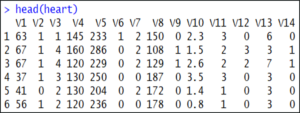 Our next step is to split the data into a training set and a testing set. This is also called data splicing.
Our next step is to split the data into a training set and a testing set. This is also called data splicing.
We’ll be using the training set specifically for our model building and the testing set for evaluating the model:
intrain <- createDataPartition(y = heart$V14, p= 0.7, list = FALSE)
training <- heart[intrain,]
testing <- heart[-intrain,]The caret package provides a method createDataPartition(), which is basically for partitioning our data into train and test set.
We’ve passed 3 parameters to this createdatapartition() function:
- The “y” parameter takes the value of variable according to which data needs to be partitioned. In our case, target variable is at V14, so we are passing heart$V14
- The “p” parameter holds a decimal value in the range of 0-1. It’s to show the percentage of the split. We are using p=0.7. It means that data split should be done in 70:30 ratio. So, 70% of the data is used for training and the remaining 30% is for testing the model.
- The “list” parameter is for whether to return a list or matrix. We are passing FALSE for not returning a list
Now this createDataPartition() method is returning a matrix “intrain.” This intrain matrix has our training data set and we’re storing this in the ‘training’ variable and the rest of the data, i.e. the remaining 30% of the data is stored in the testing variable.
Next, for checking the dimensions of our training data frame and testing data frame, we can use these:
dim(training);
dim(testing);Our next step is to clean the data, so if there are any missing values or inconsistent values, they have to be dealt with before we build the training model
We’ll be using the anyNA() method, which checks for any null values:
anyNA(heart)On running this, we get the return values as false, which means that there are no missing values in our dataset.
Next, we’re checking the summary of our data by using the summary() function
summary(heart)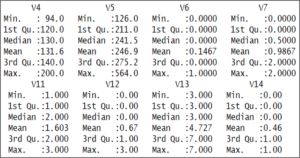 The output shows that the values of the various variables are not standardized.
The output shows that the values of the various variables are not standardized.
For example, the V14 variables, which is our target variable, it holds only 2 values, either 0 or 1.
Instead, this should be a categorical variable. To convert these to categorical variables, we need to factorize them:
training[["V14"]] = factor(training[["V14"]])The above code will convert the training data frame’s “V14” column to a factor variable.
Our next step is to train our model.
Before we train our model, we’ll first implement the trainControl() method. This will control all the computational overheads so that we can use the train() function provided by the caret package. The training method will train our data on different algorithms.
First, let’s focus on the traincontrol() method:
trctrl <- trainControl(method = "repeatedcv", number = 10, repeats = 3)The trainControl() method here, is taking 3 parameters.
- The “method” parameter defines the resampling method, in this demo we’ll be using the repeatedcv or the repeated cross-validation method.
- The next is the “number” parameter, which basically holds the number of resampling iterations.
- The “repeats ” parameter contains the sets to compute for our repeated cross-validation. We are using setting number =10 and repeats =3
This trainControl() method returns a list. We are going to pass this on our train() method.
svm_Linear <- train(V14 ~., data = training, method = "svmLinear",
trControl=trctrl,
preProcess = c("center", "scale"),
tuneLength = 10)The train() method should be passed with “method” parameter as “svmLinear”. We are passing our target variable V14. The “V14~.” denotes a formula for using all attributes in our classifier and V14 as the target variable. The “trControl” parameter should be passed with results from our trianControl() method. The “preProcess” parameter is for preprocessing our training data.
We are passing 2 values in our “pre-process”, “center,” and “scale” parameters.
These two help for centering and scaling the data.
After pre-processing, these convert our training data with mean value as approximately “0” and standard deviation as “1”. The “tuneLength” parameter holds an integer value. This is for tuning our algorithm.
You can check the result of our train() method. We are saving its results in the svm_Linear variable.
svm_Linear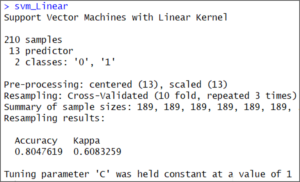 It’s a linear model. Therefore, it just tested at value “C” =1.
It’s a linear model. Therefore, it just tested at value “C” =1.
Now, our model is trained with C value as 1. We are ready to predict classes for our test set. We can use the predict() method.
The caret package provides the predict() method for predicting results. We are passing 2 arguments. Its first parameter is our trained model and second parameter “newdata” holds our testing data frame. The predict() method returns a list, we are saving it in a test_pred variable.
test_pred <- predict(svm_Linear, newdata = testing)
test_pred Now let’s check the accuracy of our model. We’re going to use the confusion matrix to predict the accuracy:
Now let’s check the accuracy of our model. We’re going to use the confusion matrix to predict the accuracy:
confusionMatrix(table(test_pred, testing$V14)) The output shows that our model accuracy for test set is 86.67%.
The output shows that our model accuracy for test set is 86.67%.
By following the above procedure, we can build our svmLinear classifier.
We can also do some customization for selecting C value(Cost) in Linear classifier. This can be done by inputting values in grid search.
The next code snippet will show you, building & tuning of an SVM classifier with different values of C.
We are going to put some values of C using expand.grid() into “grid” dataframe. The next step is to use this dataframe for testing our classifier at specific C values. It needs to be put in train() method with tuneGrid parameter.
grid <- expand.grid(C = c(0,0.01, 0.05, 0.1, 0.25, 0.5, 0.75, 1, 1.25, 1.5, 1.75, 2,5))
svm_Linear_Grid <- train(V14 ~., data = training, method = "svmLinear",
trControl=trctrl,
preProcess = c("center", "scale"),
tuneGrid = grid,
tuneLength = 10)
svm_Linear_Grid
plot(svm_Linear_Grid)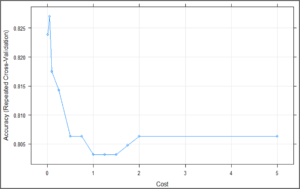 The above plot is showing that our classifier is giving best accuracy on C = 0.05. Let’s try to make predictions using this model for our test set.
The above plot is showing that our classifier is giving best accuracy on C = 0.05. Let’s try to make predictions using this model for our test set.
test_pred_grid <- predict(svm_Linear_Grid, newdata = testing)
test_pred_gridLet’s check its accuracy using confusion -matrix.
confusionMatrix(table(test_pred_grid, testing$V14))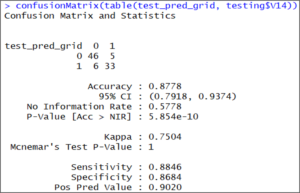
The results of the confusion matrix show that this time the accuracy on the test set is 87.78%, which is more accurate than our previous result.
With this, we come to the end of this blog. I hope you found this informative and helpful.
Further Reading
Published at DZone with permission of Zulaikha Geer, DZone MVB. See the original article here.
Opinions expressed by DZone contributors are their own.

Comments